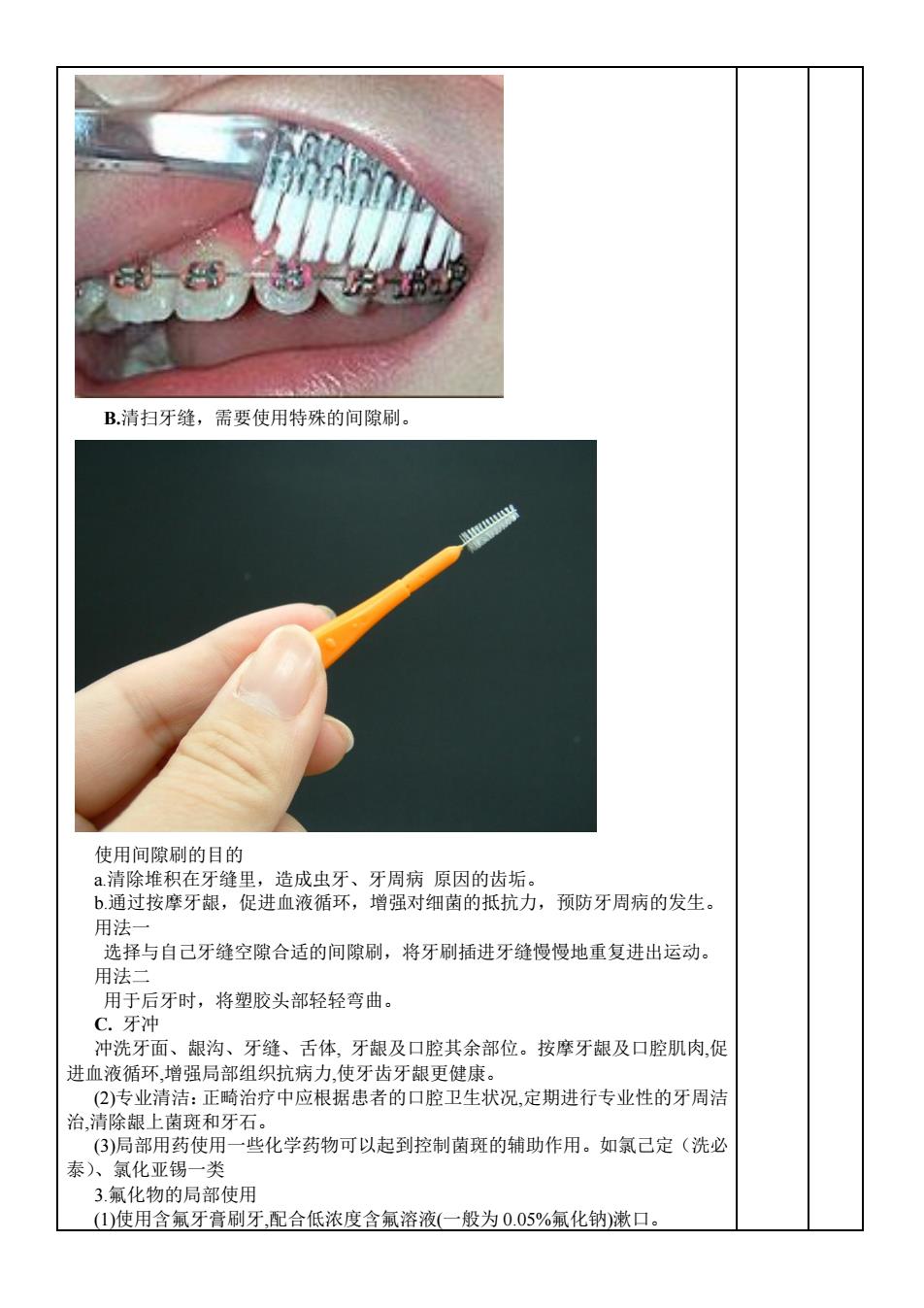
B清扫牙缝,需要使用特殊的间隙刷 使用间隙刷的目的 a清除堆积在牙缝里,造成虫牙、牙周病原因的齿垢。 b.通过按摩牙龈,促进血液循环,增强对细菌的抵抗力,预防牙周病的发生。 用法 选择与自己牙缝空隙合适的间隙刷,将牙刷插进牙缝慢慢地重复进出运动。 用法二 用于后牙时,将塑胶头部轻轻弯曲。 C.牙冲 冲洗牙面、龈沟、牙缝、舌体,牙龈及口腔其余部位。按摩牙龈及口腔肌肉,促 进血液循环,增强局部组织抗病力,使牙齿牙龈更健康。 (2)专业清洁:正畸治疗中应根据患者的口腔卫生状况,定期进行专业性的牙周洁 治,清除龈上菌斑和牙石。 (3)局部用药使用一些化学药物可以起到控制菌斑的辅助作用。如氯己定(洗必 泰)、氯化亚锡一类 3.氟化物的局部使用 (①使用含氟牙膏刷牙,配合低浓度含氟溶液(一般为0.05%氟化钠)漱口
B.清扫牙缝,需要使用特殊的间隙刷。 使用间隙刷的目的 a.清除堆积在牙缝里,造成虫牙、牙周病 原因的齿垢。 b.通过按摩牙龈,促进血液循环,增强对细菌的抵抗力,预防牙周病的发生。 用法一 选择与自己牙缝空隙合适的间隙刷,将牙刷插进牙缝慢慢地重复进出运动。 用法二 用于后牙时,将塑胶头部轻轻弯曲。 C. 牙冲 冲洗牙面、龈沟、牙缝、舌体, 牙龈及口腔其余部位。按摩牙龈及口腔肌肉,促 进血液循环,增强局部组织抗病力,使牙齿牙龈更健康。 (2)专业清洁:正畸治疗中应根据患者的口腔卫生状况,定期进行专业性的牙周洁 治,清除龈上菌斑和牙石。 (3)局部用药使用一些化学药物可以起到控制菌斑的辅助作用。如氯己定(洗必 泰)、氯化亚锡一类 3.氟化物的局部使用 (1)使用含氟牙膏刷牙,配合低浓度含氟溶液(一般为 0.05%氟化钠)漱口

(2)粘接托槽后,在局部隔湿后使用氟凝胶、氟泡沫处理牙面。 (3)使用玻璃离子粘固剂粘带环或托槽。 4.调整和规范一些正畸临床操作 ()使用酸蚀凝胶,控制酸蚀的面积 (2)粘接托槽后应清除其周围多余的粘接剂 ()选择大小合适的带环,尽可能使带环的边缘位于牙齿龈缘以上。 (4)尽可能减少由正畸装置带来的不易清洁的牙面区域。 5)不要过度的唇颊向开展牙齿。 (6)对于牙周疾病患者, 多使用直接粘接的颊面管 ()对脱矿病损和牙周组织损害的治疗 轻度的釉质脱矿可以使用再矿化方法促进釉质再矿化。 当牙龈增生明显,应暂时停止牙齿的矫正而进行系统的牙周治疗,对于过度增 生的牙龈可以采取牙龈切除术,对有合创伤的牙齿进行适当的调合,消除早接触 第十二章保持Retention 5分钟 A.What is Retention 1The final phase oforthodontictreatment is that have been moved one by mechanical appliances have a tendency to retum to their former positions.Orthodontists have long been aware of this fact.It is the purpose of retention to counteract this tendency. 2 A working definition of retention in relation to orthodontics might be stated as fllows:the holding of teeth in ideal esthetic and functional positions. 3 Relapse has been defined by the British Standards Institute as the retun,following comectio fthe features of 4 Orthodontic control of tooth Retention should not be relegated to being an afterthought at the end of treatment.it should be considered at the planning stage and explained to the patient as an integral part of the overall treatment. 5 The retention phase is considered by some to be one of the most difficult aspects of the entire 6The requirements for retention are often decided at the time of diagnosis and treatment planning.The correct diagnosis,logical treatment plan,and the timing of treatment plan must be directed toward ideal esthetics,ideal function,and the permanent maintenance of these ideals. 7A satisfactory balance of utility,beauty,and stability often simplifies (and may even avoid) retention by mechanical appliances.On the other hand,diagnosis or treatment complicate for retention 8 Gross expansion of the dental arches,severe changes in arch form,incomplete correction of anteroposterior malrelationships,and uncorrected rotations may require retentive measures. However,it is unnecessary to attempt to classify them. 9In addition,it is advisable to identify those cases where the prognosis for a stable result has to t Therson one wa te complcter avold rla Atthend fmenrmo the bruees polish the teeth.make study models and take photographs.And then take the patient ou the back door of the office and shoot him 0分 Dr Tom Graber DMD 钟 B.Why is Retention Necessary? Major reasons:(1)the gingival and periodontal tissues are affected by orthodontic tooth movement and require time for reorganization when the appliances are removed:(2)
(2)粘接托槽后,在局部隔湿后使用氟凝胶、氟泡沫处理牙面。 (3)使用玻璃离子粘固剂粘带环或托槽。 4.调整和规范一些正畸临床操作 (1)使用酸蚀凝胶,控制酸蚀的面积。 (2)粘接托槽后应清除其周围多余的粘接剂。 (3)选择大小合适的带环,尽可能使带环的边缘位于牙齿龈缘以上。 (4)尽可能减少由正畸装置带来的不易清洁的牙面区域。 (5)不要过度的唇颊向开展牙齿。 (6)对于牙周疾病患者,多使用直接粘接的颊面管。 (三)对脱矿病损和牙周组织损害的治疗 轻度的釉质脱矿可以使用再矿化方法促进釉质再矿化。 当牙龈增生明显,应暂时停止牙齿的矫正而进行系统的牙周治疗,对于过度增 生的牙龈可以采取牙龈切除术,对有合创伤的牙齿进行适当的调合,消除早接触。 第十二章 保持 Retention A .What is Retention 1 The final phase of orthodontic treatment is retention. Teeth that have been moved in or through bone by mechanical appliances have a tendency to return to their former positions. Orthodontists have long been aware of this fact. It is the purpose of retention to counteract this tendency. 2 A working definition of retention in relation to orthodontics might be stated as fllows: the holding of teeth in ideal esthetic and functional positions. 3 Relapse has been defined by the British Standards Institute as the return, following correction, of the features of the original malocclusion. 4 Orthodontic control of tooth Retention should not be relegated to being an afterthought at the end of treatment; it should be considered at the planning stage and explained to the patient as an integral part of the overall treatment. 5 The retention phase is considered by some to be one of the most difficult aspects of the entire orthodontic treatment process. 6 The requirements for retention are often decided at the time of diagnosis and treatment planning. The correct diagnosis, logical treatment plan, and the timing of treatment plan must be directed toward ideal esthetics, ideal function, and the permanent maintenance of these ideals. 7 A satisfactory balance of utility, beauty, and stability often simplifies (and may even avoid) retention by mechanical appliances. On the other hand, incorrect diagnosis or treatment complicates the requirements for retention. 8 Gross expansion of the dental arches, severe changes in arch form, incomplete correction of anteroposterior malrelationships, and uncorrected rotations may require retentive measures. However, it is unnecessary to attempt to classify them. 9 In addition, it is advisable to identify those cases where the prognosis for a stable result has to be guarded and a decision made whether to embark on treatment at all. 10 There is only one way to completely avoid relapse. At the end of treatment, remove the braces, polish the teeth, make study models and take photographs. And then take the patient out the back door of the office and shoot him - Dr Tom Graber DMD B. Why is Retention Necessary ? Major reasons: (l) the gingival and periodontal tissues are affected by orthodontic tooth movement and require time for reorganization when the appliances are removed; (2) 5 分钟 10 分 钟